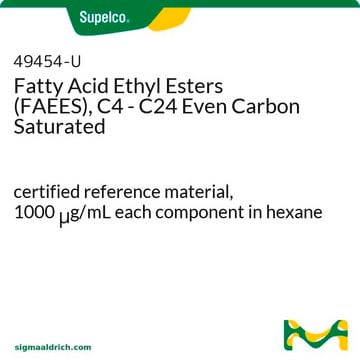All Photos(1)
About This Item
Linear Formula:
CH3(CH2)13COOC2H5
CAS Number:
Molecular Weight:
270.45
Beilstein:
1780986
EC Number:
MDL number:
UNSPSC Code:
12352100
PubChem Substance ID:
NACRES:
NA.22
Recommended Products
Quality Level
Assay
≥96.0%
form
liquid
refractive index
n20/D 1.439
mp
12-14 °C
density
0.859 g/mL at 20 °C (lit.)
functional group
ester
SMILES string
CCCCCCCCCCCCCCC(=O)OCC
InChI
1S/C17H34O2/c1-3-5-6-7-8-9-10-11-12-13-14-15-16-17(18)19-4-2/h3-16H2,1-2H3
InChI key
PTEYJUIKYIKULL-UHFFFAOYSA-N
Storage Class Code
10 - Combustible liquids
WGK
WGK 3
Flash Point(F)
Not applicable
Flash Point(C)
Not applicable
Personal Protective Equipment
dust mask type N95 (US), Eyeshields, Gloves
Choose from one of the most recent versions:
Certificates of Analysis (COA)
Lot/Batch Number
Don't see the Right Version?
If you require a particular version, you can look up a specific certificate by the Lot or Batch number.
Already Own This Product?
Find documentation for the products that you have recently purchased in the Document Library.
Teresa S Gross et al.
Pediatric research, 81(3), 461-467 (2016-11-10)
The health implications of in utero alcohol exposure have been difficult to study in very-low-birth-weight newborns (VLBW) because of an inability to identify maternal alcohol exposure. Fatty acid ethyl esters (FAEEs) are elevated in meconium of alcohol-exposed term newborns. We
Theresa W Gauthier et al.
PloS one, 10(5), e0126552-e0126552 (2015-05-16)
The accumulation of fatty acid ethyl esters (FAEEs) in meconium of term newborns has been described as one potential biomarker of maternal alcohol use during pregnancy. FAEEs accumulate in multiple alcohol-exposed fetal tissues and in the placenta. Limited research has
Soo J Park et al.
Molecules (Basel, Switzerland), 25(18) (2020-09-17)
The cuticular layer of the insect exoskeleton contains diverse compounds that serve important biological functions, including the maintenance of homeostasis by protecting against water loss, protection from injury, pathogens and insecticides, and communication. Bactrocera tryoni (Froggatt) is the most destructive
Sowmya S Mohan et al.
Alcoholism, clinical and experimental research, 39(3), 434-444 (2015-02-24)
Chronic alcohol exposure alters the function of alveolar macrophages (AM), impairing immune defenses in both adult and neonatal lungs. Fatty acid ethyl esters (FAEEs) are biological markers of prenatal alcohol exposure in newborns. FAEEs contribute to alcohol-induced mitochondrial (MT) damage
Our team of scientists has experience in all areas of research including Life Science, Material Science, Chemical Synthesis, Chromatography, Analytical and many others.
Contact Technical Service







